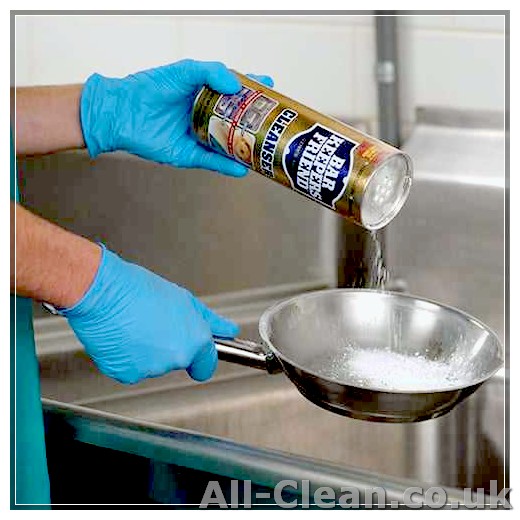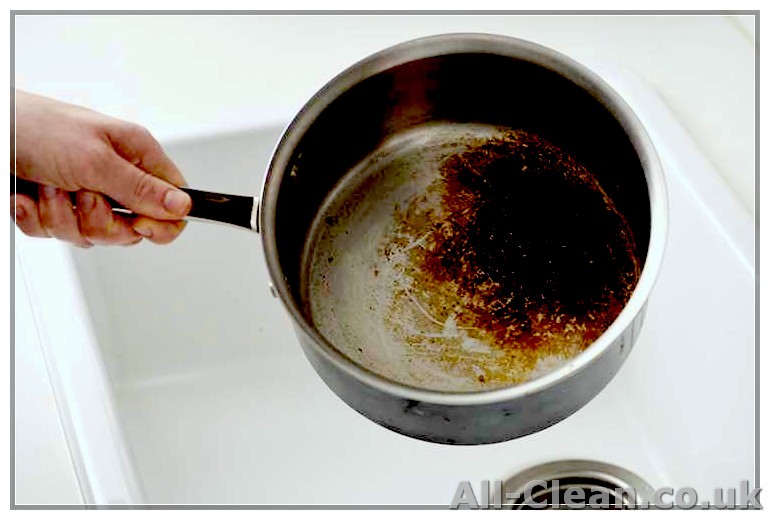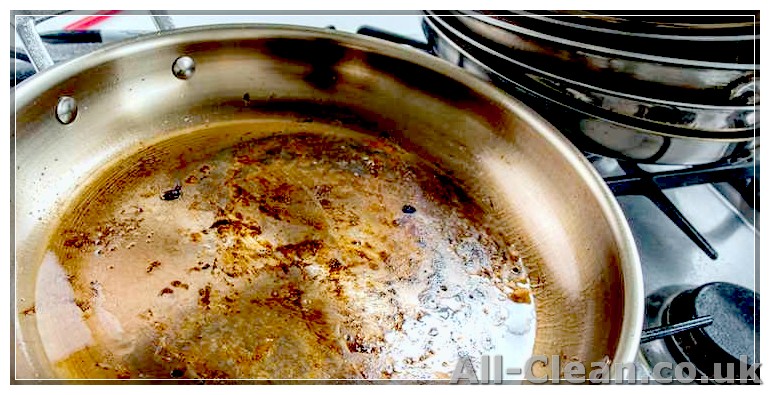
If you’ve ever accidentally burnt food in a pan, you know how frustrating it can be to clean. The burnt-on residue seems impossible to remove, and you’re worried about damaging the pan in the process. However, there are several methods you can use to clean a burnt pan quickly and effectively without causing any harm.
One method that can work wonders is baking soda and water. By sprinkling a generous amount of baking soda on the burnt area and adding a little water to form a paste, you can let it soak for a while. This will help to loosen the burnt-on food, making it easier to scrub away.
Lemons are another natural cleaning agent that can do wonders for burnt pans. Cut a lemon in half and squeeze the juice onto the bottom of the pan. Then, fill the pan with water and bring it to a boil. The acid in the lemon juice will help to lift the burnt-on food, allowing you to easily scrub it away.
If you’re unsure whether to use baking soda or lemons, another great option is vinegar. This common household item is an excellent cleaner and degreaser. Simply pour a generous amount of vinegar into the burnt pan, add some water, and let it soak for a while. The vinegar will help to break down the burnt-on residue, making it easier to scrub away.
If you’re dealing with a pan that has a non-stick coating, it’s important to take a gentler approach. Scrubbing with abrasive materials or using harsh chemicals can damage the non-stick surface. Instead, try using a paste of baking soda and water or a mild dish soap. Use a soft cloth or sponge to scrub away the residue. This should remove the burnt-on food without causing any damage to the pan.
Another method is to use a potato. Yes, you read that correctly! Cut a potato in half and sprinkle some baking soda or salt on the cut side. Use the potato to scrub the burnt area of the pan. The potato acts as a gentle abrasive, while the baking soda or salt helps to lift the burnt-on food. This method works particularly well for stainless steel and cast iron pans.
Regardless of which method you choose, there are a few general steps you should follow. First, let the pan cool down completely before attempting to clean it. Then, rinse off any loose debris and wipe away any excess grease or oil. Next, apply your chosen cleaning agent and let it sit for a while to loosen the burnt-on residue. Finally, scrub the pan gently with a sponge or brush, using warm water and dish soap if needed. Rinse the pan thoroughly and dry it completely. Following these steps will ensure that your pan is clean and ready to use again.
In conclusion, cleaning a burnt pan doesn’t have to be a daunting task. With these six easy methods – baking soda and water, lemons, vinegar, mild dish soap, potato, and gentle scrubbing – you can banish stubborn burnt-on residue and restore your cookware to its former glory. Remember to always take proper care of your pans to avoid burning your food and ensure their longevity.
- Use Baking Soda and Vinegar
- What You’ll Need
- Instructions
- Try the Boiling Method
- Utilize the Power of Salt
- Give Lemon Juice a Shot
- Materials Needed:
- Step 1: Squeeze the Lemon Juice
- Step 2: Mix with Water
- Step 3: Heat the Solution
- Step 4: Remove from Heat and Let it Sit
- Step 5: Scrub the Pan
- Step 6: Rinse and Dry
- Use a Dryer Sheet for Tough Burn Marks
- Try Commercial Cleaners
Use Baking Soda and Vinegar
If you’ve burnt your pan and it’s proving to be a stubborn mess, try this age-old approach using common ingredients you likely already have at home: baking soda and vinegar. However, it’s important to note that this method may not be suitable for all types of cookware, so proceed with caution.
What You’ll Need
- Baking soda
- Vinegar
- Water
- A scrubbing brush or sponge
- A soft cloth
Instructions
- Start by allowing the burnt pan to cool completely. This is crucial as attempting to clean a hot pan can be dangerous and may cause further damage.
- Once the pan has cooled, remove any burnt-on food residue using a gentle scraping tool, such as a plastic spatula or wooden spoon. Be careful not to scratch the surface of the pan.
- Rinse the pan with warm water to remove any loose debris.
- In a small bowl, create a paste by mixing equal parts baking soda and water. Start with a couple of tablespoons of each ingredient and adjust as needed.
- Apply the baking soda paste to the burnt areas of the pan, ensuring a thick and even coating. Use your fingers or a gentle scrubbing brush to spread the paste evenly.
- Pour a small amount of vinegar onto the baking soda paste and watch as it starts to foam. The chemical reaction between the two ingredients will help loosen the stubborn burnt residue.
- Allow the mixture to sit on the pan for at least 10 minutes. This gives the baking soda and vinegar time to work their magic on the burnt-on mess.
- After the soaking time, use a scrub brush or sponge to gently scrub the pan’s surface. Apply some pressure, but be careful not to scrub too hard, especially if you’re dealing with a non-stick or delicate pan.
- Rinse the pan thoroughly with warm water to remove any leftover baking soda and vinegar.
- Inspect the pan to see if there are any remaining burnt spots. If there are, repeat the process or move on to another cleaning method.
- Once the pan is clean, dry it with a soft cloth to remove any excess moisture.
Note: Never use baking soda and vinegar to clean copper, aluminum, or cast iron pans, as this can cause damage to the surfaces.
This easy and natural method using baking soda and vinegar is a great way to tackle burnt-on residue without resorting to harsh chemicals. Remember to always be cautious with your cookware and choose the cleaning method that is most appropriate for your specific pan.
Try the Boiling Method

If none of the previous methods work to clean your burnt pan, you can try the boiling method. This method is safe to use with most pans, but it is best to avoid using it with non-stick pans, as boiling water for an extended period of time may damage the non-stick coating.
- Fill the burnt pan with water: Fill the burnt pan with water, making sure that the water level is above the burnt marks. You can also add a few drops of liquid dish soap or a sprinkle of baking soda to help break down the grease.
- Boil the water: Place the pan on the stove and bring the water to a boil. Let it boil for about 10 minutes.
- Scrub the pan: After boiling, remove the pan from the heat and carefully pour out the water. Use a scrub brush or sponge to lightly scrub the burnt areas. The heat from the boiling water should have loosened the burnt residue, making it easier to remove.
- Rinse and dry: Rinse the pan with warm water to remove any soap or baking soda residue. Dry the pan thoroughly to prevent any future marks.
This boiling method is effective for cleaning burnt pans because the heat from the boiling water helps to loosen and break down the burnt residue. It is a simple and easy way to clean your pans without the need for harsh cleaners or excessive scrubbing.
Utilize the Power of Salt

If you’re dealing with a burnt pan, one of the simplest and most effective methods to clean it is by using salt. Salt acts as a natural exfoliator and helps to remove stubborn burnt-on marks without damaging the surface of your cookware.
Here’s a step-by-step guide on how to clean your burnt pan using salt:
- Start by removing any leftover food or debris from the pan. You can use a spatula or a soft brush to gently scrape off any large chunks.
- Rinse the pan with warm water to remove any loose residue.
- Sprinkle a generous amount of salt onto the burnt areas of the pan. Make sure to cover the entire surface.
- Add a couple of drops of water or a small amount of soap to the pan. This will create a paste-like consistency.
- Using a scrub brush or a sponge, gently scrub the burnt areas in circular motions. The salt will act as an abrasive and help to loosen the burnt-on stains.
- Rinse the pan thoroughly with warm water to remove the salt and soap residue.
- If there are still some stubborn burnt-on marks remaining, you can repeat the process or try one of the other methods mentioned above.
This simple and inexpensive method should be safe to use on most types of cookware, including stainless steel and non-stick pans. However, you should always check the manufacturer’s instructions for specific cleaning recommendations.
So, the next time you find yourself with a burnt pan, reach for the salt in your pantry and banish those burnt-on stains with ease!
Give Lemon Juice a Shot
One of the easiest and most effective methods to clean a burnt pan is by using lemon juice. Lemon juice contains natural acids that help to break down grease and lift stubborn burnt-on stains. Plus, lemons are readily available in most kitchens, making this method convenient and budget-friendly.
Materials Needed:
- A lemon or lemon juice
- A damp cloth or sponge
- Water
Step 1: Squeeze the Lemon Juice
Squeeze the juice from a lemon into the burnt pan. Alternatively, you can use bottled lemon juice.
Step 2: Mix with Water
Add a couple of tablespoons of water to the lemon juice in the pan and mix well. This will dilute the lemon juice slightly, making it more effective.
Step 3: Heat the Solution

Place the pan on the stovetop and heat the lemon juice solution until it starts to boil. Let it boil for a minute or two.
Step 4: Remove from Heat and Let it Sit
Take the pan off the heat and let the lemon juice solution sit for about 10-15 minutes. This will allow the acid in the lemon juice to loosen the burnt-on stains.
Step 5: Scrub the Pan
After letting the pan sit, scrub it gently with a sponge or cloth. The burnt-on stains should start to lift easily, and you may not need much scrubbing.
Step 6: Rinse and Dry
Rinse the pan with warm water to remove any residue. Dry the pan thoroughly before using it or storing it.
Using lemon juice to clean a burnt pan is not only a great way to remove tough stains, but it also leaves a fresh citrus scent. Additionally, lemon juice is a natural cleaning solution that is safer for you and the environment compared to chemical cleaners.
Give this method a try the next time you are dealing with a stubborn burnt pan. You’ll be amazed at how well it works and how easy it is to restore your pan to its former glory!
Use a Dryer Sheet for Tough Burn Marks
If you have an aged pan with tough burn marks, you can try using a dryer sheet to tackle the problem. These dryer sheets are not only for laundry, but they can also work wonders on burnt-on food stains in your pans.
Here’s how you can use a dryer sheet to clean your burnt pan:
- Fill your pan with warm water and add a dryer sheet to it. Let it soak for a few hours or overnight. The warm water will help loosen the burnt-on food, while the dryer sheet works its magic.
- After the pan has soaked, remove the dryer sheet and drain the water.
- Mix some baking soda with water to create a paste. Apply the paste to the burnt areas of the pan.
- Using a non-abrasive sponge or cloth, scrub the burnt-on food stains gently. The dryer sheet and baking soda mixture will work together to remove the stubborn marks.
- Rinse the pan thoroughly with warm water to remove any leftover baking soda.
- Wipe the pan dry with a clean cloth or towel.
This method is safe to use on stainless steel pans and should not damage the surface. However, never use this method on non-stick pans, as it can strip away the non-stick coating.
Using a dryer sheet is an easy and effective way to remove burnt-on food from your pans without the need for excessive scrubbing. Plus, the warm water soaking step helps to prevent future burn marks.
So next time you’re faced with a burnt pan, give this dryer sheet method a try, and banish those stubborn marks away!
Try Commercial Cleaners

If the usual pantry staples and at-home solutions aren’t doing the trick, it may be time to turn to commercial cleaners. There are several great options on the market that can help you remove burnt-on residue from your pans without damaging the surface.
Baking Soda – Baking soda is a go-to ingredient for cleaning around the house, and it works wonders on burnt pans too. Sprinkle a generous amount of baking soda onto the burnt area and then pour a small amount of water over it to create a paste. Let it sit for a couple of hours, then use a scrubbing pad to gently scrub away the stains.
Coca-Cola – Believe it or not, Coca-Cola can also be used to clean burnt pans. Pour a can of Coke into the pan and bring it to a boil. Let it simmer for a few minutes, then empty the pan and scrub away the burnt-on residue. The acid in the soda helps to lift and break down the burnt bits.
Commercial Cleaners – There are many commercial cleaners specifically designed for cleaning burnt pans. Some popular options include Bar Keepers Friend, Easy-Off, and CLR. These cleaners are formulated to cut through grease and grime, making them perfect for tackling stubborn burnt-on food.
Steel Wool – For really tough, scorched pans, steel wool can be your best friend. Use a light touch and a small amount of cleaner to scrape away burned-on food and grease. Just be careful not to scrub too hard, as steel wool can scratch the surface of some cookware.
Table Salt and Vinegar – Another effective method is to sprinkle a generous amount of table salt onto the burnt area and then pour white vinegar over it. Let the mixture sit for a few hours, then scrub away the burnt-on residue. The abrasive nature of the salt combined with the acidity of the vinegar helps to loosen and banish tough stains.
Commercial Oven Cleaner – If you have a particularly stubborn and burnt-on mess in your pan, you can try using a commercial oven cleaner. Be sure to read the instructions carefully and follow all safety precautions. These cleaners are designed to tackle tough, baked-on stains, so they should be able to handle any burnt-on residue in your pans.
Important Advice: Whatever commercial cleaner you choose, always follow the manufacturer’s instructions and use it in a well-ventilated area. Some cleaners may require gloves or protective gear, so be sure to take the necessary precautions.
In conclusion, there are many great commercial cleaners available that can help you tackle a burnt pan. Whether you prefer a natural solution like baking soda or a more aggressive approach with commercial cleaners, you can successfully remove burnt-on residue and keep your cookware looking like new.








